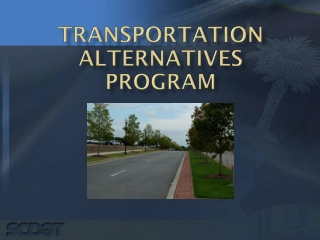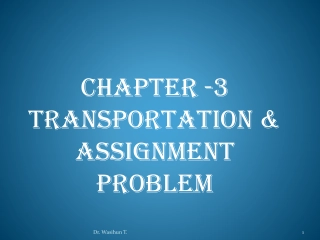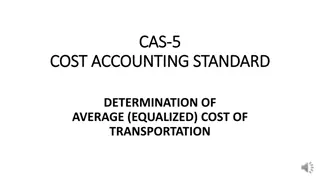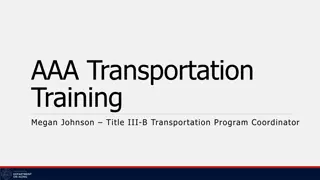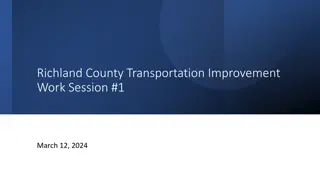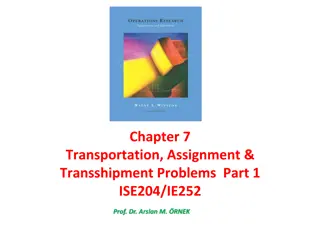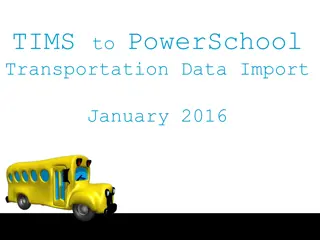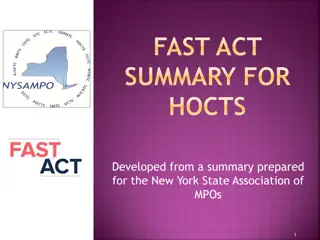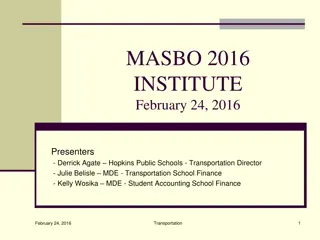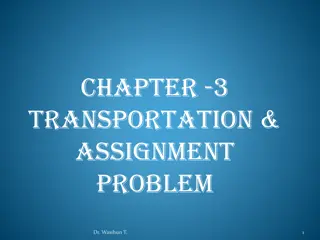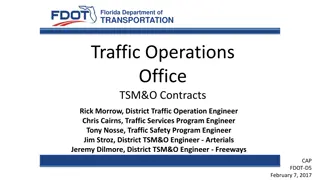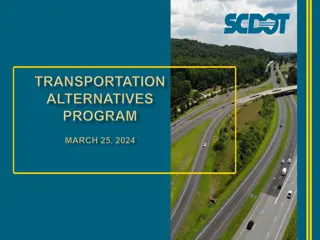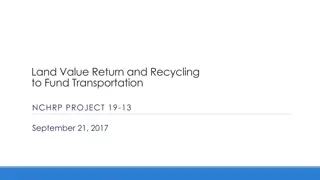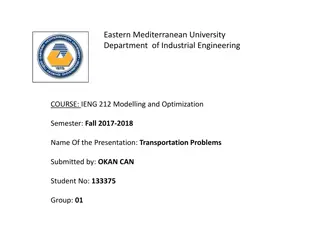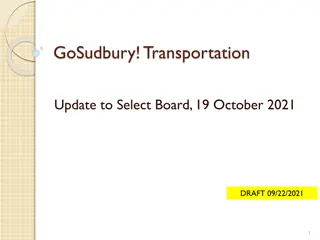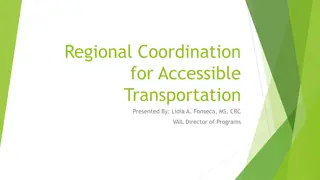Transportation Problem in Operations Research: Methods and Examples
This content explains the Transportation Problem in Operations Research, focusing on minimizing distribution costs while meeting supply and demand requirements. It covers the objective, methods including North West Corner, Least Cost, and Vogel Approximation, and provides an example scenario with calculations.
Download Presentation

Please find below an Image/Link to download the presentation.
The content on the website is provided AS IS for your information and personal use only. It may not be sold, licensed, or shared on other websites without obtaining consent from the author.If you encounter any issues during the download, it is possible that the publisher has removed the file from their server.
You are allowed to download the files provided on this website for personal or commercial use, subject to the condition that they are used lawfully. All files are the property of their respective owners.
The content on the website is provided AS IS for your information and personal use only. It may not be sold, licensed, or shared on other websites without obtaining consent from the author.
E N D
Presentation Transcript
OPERATIONS RESEARCH TRANSPORTATION PROBLEM Dr.T.Sivakami Dr.T.Sivakami Assistant Professor Assistant Professor PG& Research Department of Management Studies PG& Research Department of Management Studies Bon Secours College for Bon Secours College for Women,Thanjavur Women,Thanjavur
OBJECTIVE OF TRANSPORTATION PROBLEM The objective is to minimize the cost of distributing a product from a number of sources sources (e.g. factories) destinations destinations (e.g. warehouses) while satisfying both the supply limits and the demand requirement. to a number of
METHODS OF TRANSPORTATION PROBLEM Determine a starting basic feasible solution, using any one of the following three methods North West Corner Method North West Corner Method Least Cost Method Least Cost Method Vogel Approximation Method Vogel Approximation Method
NORTH WEST CORNER METHOD NORTH WEST CORNER METHOD: The The method x x11 method starts starts at at the the North North West West (upper (upper left) left) corner corner cell cell of of the the table table (variable (variable 11) ). . Step Step - -1 1: : Allocate amounts amounts of of capacity amount amount. . Allocate as capacity (supply) as much much as (supply) and as possible possible to to the and requirement requirement (demand) the selected selected cell, (demand) by cell, and by subtracting subtracting the and adjust adjust the the associated associated the allocated allocated Step Step - -2 2: : Cross further further assignments assignments can becomes becomes zero zero simultaneously, demand demand in in the the uncrossed Cross out the row can be simultaneously, cross uncrossed out out the row (column) (column) with be made made in in that cross out out row row (column) with zero that row out one one of of them (column). . zero supply supply or or demand row (column) (column). . If If both them only, only, and demand to to indicate both the the row and leave leave a a zero indicate that row and and column zero supply supply or or that no column no Step Step - -3 3: : If If exactly to to the the cell has has been been crossed exactly one cell to to the the right crossed out one row right if if a a column out. . Go Go to to step row (column) (column) is is left column has step - -1 1. . left uncrossed uncrossed out, has just just been been crossed out, then then stop crossed or or the stop. . Otherwise, Otherwise, move the one one below below if if a a row move row
Example Example 1 1: : Luminous capacity capacity 30 30, , 50 shipped shipped to to four and and 10 10 units units per between between factories factories and Luminous lamps 50, , and and 20 four warehouses warehouses W W1 1, , W W2 2, , W W3 3, , and per week week respectively respectively. . The and warehouses warehouses are lamps has 20 units units per has three three factories per week week respectively and W W4 4with The transportation transportation costs are given given below below. . factories - - F F1 1, , F F2 2, , and respectively. . These with requirement and F F3 3with These units requirement of of 20 costs (in with production production units are are to to be 20, , 40 (in Rs Rs. .) ) per be 30, , unit 40, , 30 per unit Warehouse Warehouse / Factory / Factory W1 W1 W2 W2 W3 W3 W4 W4 supply supply F1 F1 1 1 3 3 1 1 4 4 30 30 F2 F2 3 3 3 3 3 3 1 1 50 50 F3 F3 4 4 2 2 5 5 9 9 20 20 Demand Demand 20 20 40 40 30 30 10 10
Total Transportation Cost Total Transportation Cost =(1X20)+(3X10)+(3X30)+(2X20)+(5X10)+(9X10) =(1X20)+(3X10)+(3X30)+(2X20)+(5X10)+(9X10) =20+30+90+40+50+90 =20+30+90+40+50+90 =Rs 320 =Rs 320
Total Cost=(8X50)+(6X5)+(3X35)+(3X20)+(9X40) Total Cost=(8X50)+(6X5)+(3X35)+(3X20)+(9X40) =400+35+105+60+360 =400+35+105+60+360 =Rs 960 =Rs 960
VOGEL APPROXIMATION METHOD Step Step 1 1: : For determine determine a a penalty (column) (column) from For each each row penalty by from the the next row (column) (column) with by subtracting subtracting the next smallest smallest unit with strictly strictly positive the smallest smallest unit unit cost cost element element in in the positive capacity unit cost the same capacity (requirement), (requirement), cost element element in in the same row row (column) the row (column). . row Step Step 2 2: : Identify rows rows and and columns columns columns are are equal Identify the columns. . If If the equal we the row row or or column column with the penalties penalties corresponding we select select the the topmost topmost row with the corresponding to to two row and and the the largest largest penalty penalty among two or or more the extreme extreme left among all more rows left column column. . all the rows or or the Step Step 3 3: : We or or column column with as as possible possible subject whether whether a ai ior or b bj jis is the Step Step 4 4: : The columns columns until We select select X Xij ijas with largest largest penalty subject to to the the smaller as a a basic basic variable penalty. . We the row row and smaller of of the variable if if C Cij ijis is the We choose choose the and the the column column constraints the two two i ith throw row or or j jth thcolumn the minimum minimum cost the numerical numerical value constraints. . Depending column is is crossed cost in in the value of of X Xij ijas Depending upon crossed out the row as high high upon out. . row The Step until all Step 2 2 is is now all the the basic basic variables now performed performed on variables have on the been satisfied satisfied. . the uncrossed uncrossed- -out out rows rows and and have been
NOW, COMPUTE THE PENALTY FOR VARIOUS ROWS AND COLUMNS WHICH IS SHOWN IN THE FOLLOWING TABLE
LOOK FOR THE HIGHEST PENALTY IN THE ROW OR COLUMN, THE HIGHEST PENALTY OCCURS IN THE SECOND SECOND COLUMN COLUMN AND THE MINIMUM UNIT COST IN THIS COLUMN IS C22=2. HENCE ASSIGN 20 TO THIS CELL AND CROSS OUT THE SECOND ROW THIS IS SHOWN IN THE FOLLOWING TABLE:
LOOK LOOK FOR OCCURS OCCURS IN C C23 SHOWN SHOWN IN THE HIGHEST HIGHEST PENALTY THE THIRD THIRD COLUMN 23= =4 4. . HENCE ASSIGN 30 FOR THE IN THE HENCE ASSIGN IN THE THE FOLLOWING FOLLOWING TABLE PENALTY IN COLUMN AND 30 TO TO THIS THIS CELL TABLE IN THE THE ROW AND THE THE MINIMUM CELL AND AND CROSS ROW OR MINIMUM UNIT CROSS OUT OR COLUMN, COLUMN, THE UNIT COST OUT THE THE HIGHEST HIGHEST PENALTY COST IN IN THIS THIS COLUMN THE SECOND SECOND ROW PENALTY COLUMN IS IS ROW THIS THIS IS IS
LOOK FOR THE HIGHEST PENALTY IN THE ROW OR COLUMN, THE HIGHEST PENALTY OCCURS IN THE FIRST FIRST COLUMN COLUMN AND THE MINIMUM UNIT COST IN THIS COLUMN IS C21=7. HENCE ASSIGN 25 TO THIS CELL AND CROSS OUT THE FIRST COLUMN. THIS IS SHOWN IN THE FOLLOWING TABLE
LOOK FOR THE HIGHEST PENALTY IN THE ROW OR COLUMN, THE HIGHEST PENALTY OCCURS IN THE FIRST FIRST COLUMN COLUMN AND THE MINIMUM UNIT COST IN THIS COLUMN IS C21=6. HENCE ASSIGN 6 TO THIS CELL AND CROSS OUT THE FIRST COLUMN. THIS IS SHOWN IN THE FOLLOWING TABLE
IN IN THIS THIS TABLE WE WE ASSIGN ASSIGN 15 IS IS SHOWN SHOWN IN TABLE THERE 15 IN IN THE THE FOLLOWING FOLLOWING TABLE THERE IS IS NO IN TO TO THE NO HIGHEST HIGHEST PENALTY THE FIRST FIRST CELL CELL AND TABLE PENALTY IN AND CROSS CROSS OUT IN THE THE ROW OUT THE ROW OR THE FIRST FIRST ROW OR COLUMN, COLUMN, SO, ROW. . THIS SO, THIS
HERE WE ASSIGN THE BALANCE VALUE 4 IN TO THE FIRST CELL AND THEN HERE WE ASSIGN THE BALANCE VALUE 4 IN TO THE FIRST CELL AND THEN CALCULATE THE TOTAL COST. THE TOTAL COST. CALCULATE
Total Transportation Cost Total Transportation Cost =(2X20)+(4X30)+(7X25)+(6X6)+(9X15)+(9X4) =(2X20)+(4X30)+(7X25)+(6X6)+(9X15)+(9X4) =40+120+175+36+135+36 =40+120+175+36+135+36 =RS 542 =RS 542
Thank U Thank U


